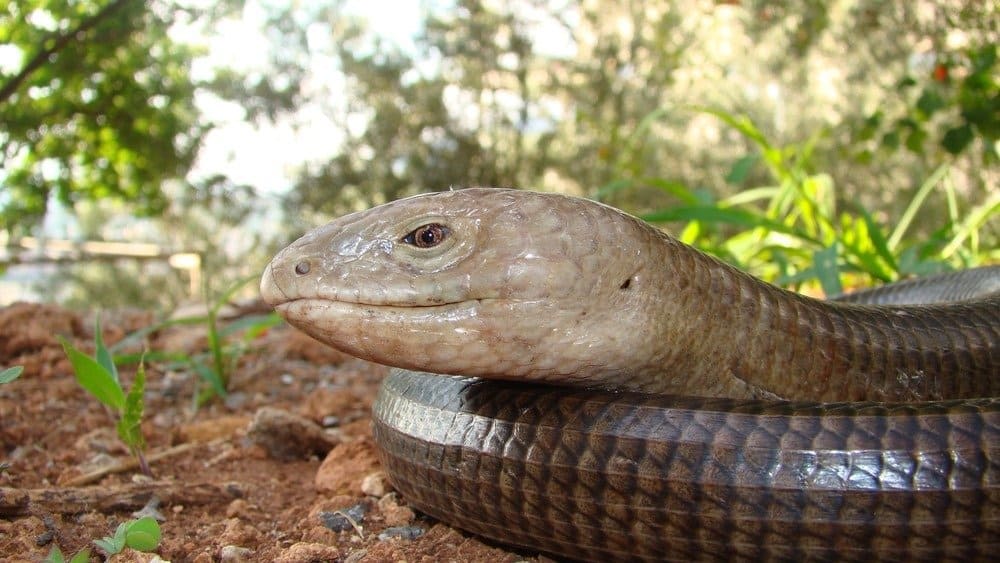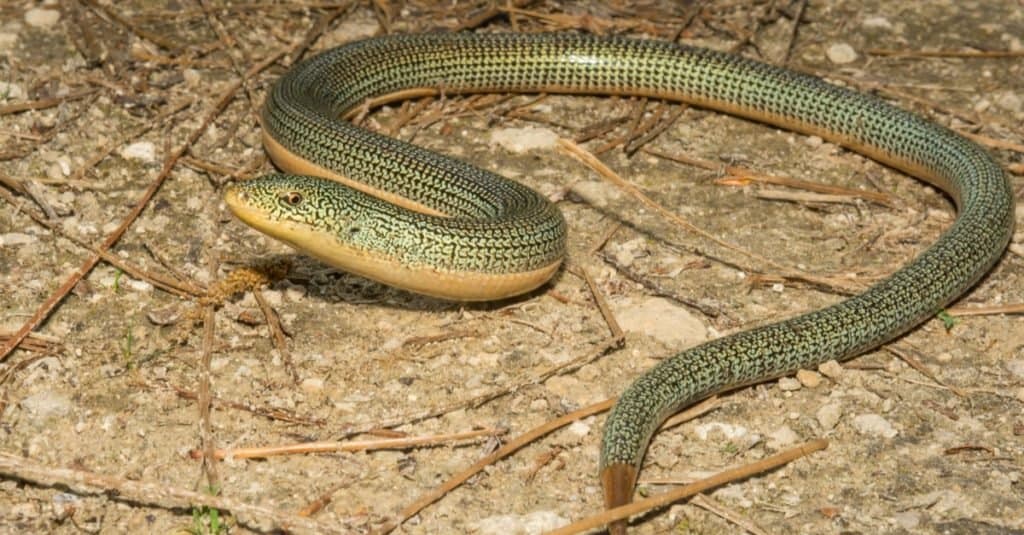Snakes are some of the most mythical creatures that live on earth. Creation stories from all around the world have stories of snakes, and people are universally terrified of them. Still, something is so fascinating about these scaly creatures. In one particular creation story, a snake loses its legs and is forced to slither for the rest of time. Today, we are going to be taking a look, not at the creation story, but at the idea of snakes having legs! Do snakes have legs? Let’s find out together!
Do snakes have legs?

Do snakes have legs? No, snakes don’t have legs. Legless
lizards
, however, do exist.
©Lauren Suryanata/Shutterstock.com
Currently, there are over 3,000 species of snake recognized globally. In nearly every environment besides the polar regions, snakes have learned how to make their home. While there aren’t too many things that universally connect snakes, there are a few features that scientists have come up with in order to better classify them.
So to the big question–do snakes have legs? To be classified as a snake, a creature within the suborder Serpentes (snakes), an animal must have no limbs, voice, external ears, or eyelids, one functional lung, and a long body. In short, snakes do not have legs. It’s actually one of the things that makes a snake a snake!
Still, despite snakes no longer having legs, that wasn’t always the case. Million of years ago, the precursors to snakes had to lose their legs in order to gain an evolutionary advantage. Let’s learn more about the ancient predecessors of snakes and how we know about them today!
Why do pythons and boas have vestigial legs?

Pythons
and boas have the vestigial remains of ancient legs long gone.
©Own work / Creative Commons – License
Although modern snakes don’t have legs, we can see that they used to have legs a few million years ago! The process of evolution is slow, but we can see the remnants of legs in a few species of snakes.
Pythons and boas are both types of large constricting snakes that have been around for a long time. In fact, many scientists believe them to be among the most “basal species” of modern snakes today. A “basal” creature is simply the earliest species that likely gave rise to other species.
As some of the earliest snakes on the timeline, we can still see the changes that happened in the near past, at least in relation to how long they have been around. One of the clearest examples of this is the vestigial legs that are unique to boas and pythons. A vestigial organ is an organ that is the remnant of an evolutionary past that doesn’t have much use in modernity. In humans, wisdom teeth and the appendix are examples of vestigial remains.
In pythons and boas, two small hind leg bones are buried in the muscles near the base of their tails. They are clearly the remains of ancient legs long gone and serve little purpose today. Still, pythons and boas seem to use these small spurs to aid in mating activities and to better hold onto tree branches.
What are legless lizards?

Legless
lizards live
all over the world.
©Dr.MYM/Shutterstock.com
Although modern snakes don’t have legs, the creatures that were around before snakes lived did – lizards! Incredibly, there is an entire segment of legless lizards that live on earth today. These reptiles don’t have legs, but they don’t have all the traits to fully classify them as a snake.
Overall, there are hundreds of species of legless lizards globally. Let’s look at some of the most interesting ones:
Glass lizards
For most people, glass lizards are what they think of when imagining a legless lizard. These lizards get their name from their ability to drop their tails as they are easily broken. Once broken, they have a tendency to break into smaller pieces like glass. There are many species of glass lizards, all of which appear totally legless or with tiny vestigial legs.
Flap-footed lizards
Flap-footed lizards are a group of legless lizards that are classified as geckos. As their name suggests, flap-footed lizards get their name from their hind legs, if you can even call them legs. They are vestigial and the only remaining organ is a small flap.
Grass lizards
Grass lizards, otherwise known as the Chamaesaura, are a genus of legless lizards from southern and eastern Africa. The lizards in this genus only have small spikes on for limbs. These lizards move like snakes, pushing their bellies against their environment in order to move.
How long ago did snakes lose their legs?

Although the
glass lizard
has no legs, it is a lizard – not a snake! Unlike snakes, glass lizards have eyelids and ears.
©Jay Ondreicka/Shutterstock.com
Currently, the best scientific estimates as to when snakes lost their legs stand at 150 million years ago. Ancient fossils help to create these estimates, although there is some give and take as to when exactly things happened. The newest fossil of a snake with legs is of a specimen known as Nagash rionegrina (the Hebrew word for snake). Nagash was the first example of a terrestrial snake species that had robust hind legs.
The photo featured at the top of this post is © Vince Adam/Shutterstock.com
Discover the "Monster" Snake 5X Bigger than an Anaconda
Every day A-Z Animals sends out some of the most incredible facts in the world from our free newsletter. Want to discover the 10 most beautiful snakes in the world, a "snake island" where you're never more than 3 feet from danger, or a "monster" snake 5X larger than an anaconda? Then sign up right now and you'll start receiving our daily newsletter absolutely free.
Thank you for reading! Have some feedback for us? Contact the AZ Animals editorial team.






